BaFe1−xCuxO3 Perovskites as Active Phase for Diesel (DPF) and Gasoline Particle Filters (GPF)
Abstract
:1. Introduction
2. Materials and Methods
2.1. Catalyst Preparation
2.2. Characterization
2.3. Activity Tests
3. Results and Discussion
3.1. Characterization of the Fresh Catalysts
3.1.1. Chemical, Morphological, and Structural Properties
3.1.2. Surface Properties
3.1.3. Redox Properties
- a)
- At low temperature, between approximately 200 °C and 550 °C, a broad H2 consumption signal is observed for all the catalyst that, according to literature, can be ascribed to different reduction processes: (i) the Cu(II) [34,38] reduction, (ii) the Fe(IV) and Fe(III) reduction to Fe(III) and Fe(II), as was observed for Fe3O4, and iii) the reduction of weakly chemisorbed oxygen upon surface oxygen vacancies of perovskite (α-oxygen) [34].
- b)
- From around 550 °C to 700 °C, the H2 consumption peaks correspond to both the reduction of Fe(III) to Fe(II) as detected for the reduction of Fe3O4 to FeO and to the decomposition of surface oxygen species formed on oxygen vacancies (called α’-oxygen) [34], more strongly bonded to the perovskite than α-oxygen.
- c)
- At high temperatures (T > 700 °C), broad TCD signals assigned to the reduction of Fe(II) to Fe(0) (causing the consequent destruction of the perovskite structure) could be found [56,57,58]. Nevertheless, the XRD data for catalysts after H2-TPR (not shown) reveal that the perovskite structure is still present, thus, the reduction to Fe(0) is not taking place and, consequently, H2 consumption is hardly observed at T > 700 °C. Therefore, the most relevant information related to the redox properties of the BaFe1−xCuxO3 catalysts is located at T < 700 °C.
3.1.4. O2 Release During Heat-Treatment in He (O2-TPD)
3.2. Catalytic Activity
3.2.1. NO2 Generation and Diesel Soot Oxidation
3.2.2. Soot Oxidation in GDI Conditions
4. Conclusions
- Partial substitution of iron by copper in the lattice of a BaFeO3 perovskite generates a distortion of the hexagonal perovskite structure for the lowest copper content catalyst (BFC1), and a change to cubic structure for the catalysts with higher copper content (BFC3 and BFC4).
- The amount of copper inserted into the perovskite framework achieve a maximum for the highest copper content catalyst (BFC4), which provokes the presence of BaOx-CuOx as a minority segregated phase.
- The positive charge deficiency due to the partial substitution of Fe by Cu seems to be balanced by the oxidation of Fe(III) to Fe(IV) in the BFC1 perovskite and by the generation of additional oxygen vacancies/defects, for BFC3 and BFC4 catalysts.
- BaFe1-xCuxO3 perovskite catalyze both the NO2-assisted diesel soot oxidation (500 ppm NO, 5% O2) and, to a lesser extent, the soot oxidation in the high demanding GDI exhaust conditions (1% O2)
- BFC0 is the most active catalyst for both oxidation reactions. The activity seems to be mainly related with the amount of O2 evolved during an O2-TPD, which decreases with the copper content of the catalyst.
Supplementary Materials
Author Contributions
Funding
Conflicts of Interest
References
- Johnson, T.V. Vehicular Emissions in Review. SAE Int. J. Engines 2014, 7, 1207–1227. [Google Scholar] [CrossRef]
- Mamakos, A.; Steininger, N.; Martini, G.; Dilara, P.; Drossinos, Y. Cost effectiveness of particulate filter installation on direct gasoline vehicles. Atmos. Environ. 2013, 77, 16–23. [Google Scholar] [CrossRef]
- Guan, B.; Zhan, R.; Lin, H.; Huang, Z. Review of the state-of-the-art of exhaust particulate filter technology in internal combustion engines. J. Environ. Manag. 2015, 154, 225–258. [Google Scholar] [CrossRef] [PubMed]
- Johnson, T.V. Vehicular Emissions in Review. SAE Int. J. Engines 2012, 5, 216–234. [Google Scholar] [CrossRef]
- Kim, C.H.; Schmid, M.; Schmieg, S.J.; Tan, J.L.; Li, W. The Effect of Pt-Pd Ratio on Oxidation Catalysts Under Simulated Diesel Exhaust. SAE Tech. Pap. 2011, 1, 337–347. [Google Scholar]
- Ad Hoc Working Group on Defining Critical Raw Materials. Report on Critical Raw Materials for the EU; Ad Hoc Working Group on Defining Critical Raw Materials: Brussels, Belgium, 2017. [Google Scholar]
- Boger, T.; Rose, D.; Nicolin, P.; Gunasekaran, N.; Glasson, T. Oxidation of Soot (Printex® U) in Particulate Filters Operated on Gasoline Engines. Emiss. Control Sci. Technol. 2015, 1, 49–63. [Google Scholar] [CrossRef]
- Hernández, W.Y.; Tsampas, M.N.; Zhao, C.; Bosselet, A.; Vernoux, P. La/Sr-Based Perovskites as Soot Oxidation Catalysts for Gasoline Particulate Filters. Catal. Today 2015, 258, 525–534. [Google Scholar] [CrossRef]
- Hernández, W.Y.; López-González, D.; Ntais, S.; Zhao, C.; Boréave, A.; Vernoux, P. Ag-based catalysts for Diesel and gasoline soot oxidation. Appl. Catal. B 2018, 226, 202–212. [Google Scholar] [CrossRef]
- Giménez-Mañogil, J.; Quiles-Díaz, S.; Guillén-Hurtado, N.; García-García, A. Catalyzed Particulate Filter Regeneration by Platinum Versus Noble Metal-Free Catalysts: From Principles to Real Application. Top. Catal. 2017, 60, 2–12. [Google Scholar] [CrossRef]
- Aneggi, E.; De Leitenburg, C.; Trovarelli, A. Ceria-based formulations for catalysts for diesel soot combustion. In Catalysis by Ceria and Related Materials; Trovarelli, A., Fornaseiro, P., Eds.; Imperial College Press: London, UK, 2013; pp. 565–621. [Google Scholar]
- Piumetti, M.; Bensai, S.; Russo, N.; Fino, D. Nanostructured ceria-based catalysts for soot combustion. Investigation on surface sensitivity. Appl. Catal. B 2015, 154, 742–751. [Google Scholar] [CrossRef]
- Castoldi, L.; Matarrese, R.; Lietti, L.; Forzatti, P. Intrinsic reactivity of alkaline and alkaline-earth metal oxide catalysts for soot oxidation. Appl. Catal. B 2009, 90, 278–285. [Google Scholar] [CrossRef]
- Obeid, E.; Tsampas, M.N.; Jonet, S.; Boréave, A.; Burel, L.; Steil, M.C.; Blanchard, G.; Pajot, K.; Vernoux, P. Isothermal catalytic oxidation of diesel soot on Ytria-stabilized zirconia. Solid State Inonics 2014, 262, 87–96. [Google Scholar]
- Obeid, E.; Lizarraga, L.; Tsampas, M.N.; Cordier, A.; Boréave, A.; Steil, M.C.; Blanchard, G.; Pajot, K.; Vernoux, P. Continously regenerating diesel particulate filters based on ionically conducting ceramic. J. Catal. 2014, 309, 87–96. [Google Scholar] [CrossRef]
- Ura, B.; Trawczynski, J.; Kotarba, A.; Bieniasz, W.; Illán-Gómez, M.J.; Bueno–López, A.; López-Suárez, F.E. Effect of potassium addition on catalytic activity of SrTiO3 catalysts for diesel soot combustion. Appl. Catal. B 2011, 101, 169–175. [Google Scholar] [CrossRef]
- Mgarajuan, S.K.; Rayalu, S.; Nishibori, M.; Teraoka, Y.; Labhsetwar, N. Effects of surface and bulk silver on PrMnO3+δ perovskite for CO and soot oxidation: Experimental evidence for the chemical state of silver. ACS Catal. 2015, 5, 301–309. [Google Scholar] [CrossRef]
- Wang, H.; Zhao, Z.; Xu, C.M.; Liu, J. Nanometric La1−xKxMnO3 Perovskite-type oxides—Highly active catalysts for the combustion of diesel soot particle under loose contact conditions. Catal. Lett. 2005, 102, 251–256. [Google Scholar] [CrossRef]
- Peña, M.A.; Fierro, J.L.G. Chemical Structures and performances of perovskite oxides. Chem. Rev. 2001, 101, 1981–2018. [Google Scholar] [CrossRef]
- Shimokawa, H.; Kusaba, H.; Einaga, H.; Teraoka, Y. Effect of surface area of La–K–Mn–O perovskite catalysts on diesel particulate oxidation. Catal. Today 2008, 139, 8–14. [Google Scholar] [CrossRef]
- Li, L.; Shen, X.; Wang, P.; Meng, X.; Song, F. Soot capture and combustion for perovskite La–Mn–O based catalysts coated on honeycomb ceramic in practical diesel exhaust. Appl. Surf. Sci. 2011, 257, 9519–9524. [Google Scholar] [CrossRef]
- Wang, J.; Su, Y.; Wang, X.; Chen, J.; Zhao, Z.; Shen, M. The effect of partial substitution of Co in LaMnO3 synthesized by sol–gel methods for NO oxidation. Catal. Commun. 2012, 25, 106–109. [Google Scholar] [CrossRef]
- Peng, X.S.; Lin, H.; Shangguan, W.F.; Huang, Z. Surface Properties and Catalytic Performance of La0.8K0.2CuxMn1–xO3 for Simultaneous Removal of NOx and Soot. Chem. Eng. Technol. 2007, 30, 99–104. [Google Scholar] [CrossRef]
- Doggali, P.; Kusaba, S.; Teraoka, Y.; Chankapure, P.; Rayaluand, S.; Labhsetwar, N. La0.9Ba0.1CoO3 perovskite type catalysts for the control of CO and PM emissions. Catal. Commun. 2010, 11, 665–669. [Google Scholar] [CrossRef]
- Gao, Y.; Wu, X.; Liu, S.; Weng, D.; Zhang, H.; Ran, R. Formation of BaMnO3 in Ba/MnOx–CeO2 catalyst upon the hydrothermal ageing and its effects on oxide sintering and soot oxidation activity. Catal. Today 2015, 253, 83–88. [Google Scholar] [CrossRef]
- Torregrosa-Rivero, V.; Albaladejo-Fuentes, V.; Sánchez-Adsuar, M.S.; Illán-Gómez, M.J. Copper doped BaMnO3 perovskite catalysts for NO oxidation and NO2-assisted diesel soot removal. RSC Adv. 2017, 7, 35228–35238. [Google Scholar] [CrossRef]
- Dai, H.X.; He, H.; Li, W.; Gao, Z.Z.; Au, C.T. Perovskite-type oxide ACo0.8Bi0.2O2.87 (A = La0.8 Ba0.2): A catalyst for low-temperature CO oxidation. Catal. Lett. 2001, 73, 149–156. [Google Scholar] [CrossRef]
- Borovskikh, L.; Mazo, G.; Kemnitz, E. Reactivity of oxygen of complex cobaltates La1−xSrxCoO3-δ and LaSrCoO4. Solid State Sci. 2003, 5, 409–417. [Google Scholar] [CrossRef]
- Isupova, L.A.; Rogov, V.A.; Yakovleva, I.S.; Alikina, G.M.; Sadykov, V.A. Oxygen States in Oxides with a Perovskite Structure and Their Catalytic Activity in Complete Oxidation Reactions: System La1–x CaxFeO3-y (x = 0–1). Kinet. Catal. 2004, 45, 446–453. [Google Scholar] [CrossRef]
- Yakovleva, I.S.; Isupova, L.A.; Tsybulyaa, S.V.; Chernysh, N.N.; Boldyreva, G.; Alikina, G.M.; Sadykov, V.A. Mechanochemical synthesis and reactivity of La1−xSrxFeO3-y perovskite (0 <x <1). J. Mater. Sci. 2004, 39, 5517–5521. [Google Scholar]
- Yan, X.; Huang, Q.; Li, B.; Xu, X.; Chen, Y.; Zhu, S.; Shen, S. Catalytic performance of LaCo0.5M0.5O3 (M = Mn, Cr, Fe, Ni, Cu) perovskite-type oxides and LaCo0.5Mn0.5O3 supported on cordierite for CO oxidation. J. Ind. Eng. Chem. 2013, 19, 561–565. [Google Scholar] [CrossRef]
- Yang, W.; Zhang, R.; Chen, B.; Bion, N.; Duprez, D.; Royer, S. Activity of perovskite-type mixed oxides for the low-temperature CO oxidation: Evidence of oxygen species participation from the solid. J. Catal. 2012, 295, 45–58. [Google Scholar] [CrossRef]
- Seyfi, B.; Baghalha, M.; Kazemian, H. Modified LaCoO3 nano-perovskite catalysts for the environmental application of automotive CO oxidation. Chem. Eng. J. 2009, 148, 306–311. [Google Scholar] [CrossRef]
- Albaladejo-Fuentes, V.; López-Suárez, F.E.; Sánchez-Adsuar, M.S.; Illán-Gómez, M.J. Tailoring the properties of BaTi0.8Cu0.2O3 catalyst selecting the synthesis method. Appl. Catal. A 2016, 519, 7–15. [Google Scholar] [CrossRef]
- Moreno-Marcos, C.; Torregrosa-Rivero, V.; Albaladejo-Fuentes, V.; Sánchez-Adsuar, M.S.; Illán-Gómez, M.J. BaFe1−xCuxO3 Perovskites as Soot Oxidation Catalysts for Gasoline Particulate Filters (GPF): A Preliminary Study. Top. Catal. 2019, 62, 413–418. [Google Scholar] [CrossRef]
- López-Suárez, F.E.; Parres-Esclapez, S.; Bueno-López, A.; Illán-Gómez, M.J.; Ura, B.; Trawczynski, J. Role of surface and lattice copper species in copper-containing (Mg/Sr)TiO3 perovskite catalysts for soot combustion. Appl. Catal. B 2009, 93, 82–89. [Google Scholar] [CrossRef]
- López-Suárez, F.E.; Bueno-López, A.; Illán-Gómez, M.J.; Trawczynski, J. Potassium-copper perovskite catalysts for mild temperature diesel soot combustión. Appl. Catal. A 2014, 485, 214–221. [Google Scholar] [CrossRef]
- Albaladejo-Fuentes, V.; López-Suárez, F.E.; Sánchez-Adsuar, M.S.; Illán-Gómez, M.J. BaTi1−xCuxO3 perovskites: The effect of copper content in the properties and in the NOx storage capacity. Appl. Catal. A Gen. 2014, 488, 189–199. [Google Scholar] [CrossRef]
- Huang, C.; Zhu, Y.; Wang, X.; Liu, X.; Wang, J.; Zhang, T. Sn promoted BaFeO3−δ catalysts for N2O decomposition: Optimization of Fe active centers. J. Catal. 2017, 347, 9–20. [Google Scholar] [CrossRef]
- Langford, J.I.; Wilson, A.J.C. Scherrer after sixty years: A survey and some new results in the determination of crystallite size. J. Appl. Cryst. 1978, 11, 102–113. [Google Scholar] [CrossRef]
- Chen, X.; Huang, L.; Wei, Y.; Wang, H. Tantalum stabilized SrCoO3−δ perovskite membrane for oxygen separation. J. Membr. Sci. 2011, 368, 159–164. [Google Scholar] [CrossRef]
- Ghijsen, J.; Tjeng, L.H.; Van Elp, J.; Eskes, H.; Westerink, J.; Sawatzky, G.A.; Czyzyk, M.T. Electronic structure of Cu2O and CuO. Phys. Rev. B 1988, 38, 11322–11330. [Google Scholar] [CrossRef]
- Espinós, J.P.; Morales, J.; Barranco, A.; Caballero, A.; Holgado, J.P.; González-Elipe, A.R. Interface Effects for Cu, CuO, and Cu2O Deposited on SiO2 and ZrO2. XPS Determination of the Valence State of Copper in Cu/SiO2 and Cu/ZrO2 Catalysts. J. Phys. Chem. B 2002, 106, 6921–6929. [Google Scholar] [CrossRef]
- Benoit, R. Centre de Recherche sur la Matière Divisée—CNRS. 2013. Available online: www.lasurface.com (accessed on 1 January 2019).
- Biesinger, M.C. Advance analysis of copper X-ray photelectron spectra. Surf. Interface Anal. 2017, 49, 1325–1334. [Google Scholar] [CrossRef]
- Biesinger, M.C.; Payne, A.P.; Grosvenor, L.W.M.; Lau, F.; Wei, A.R.; Gerson, R.S.C. Smart resolving surface chemical states in XPS analysis of firts row transition metals oxides and hydroxides: Cr, Mn, Fe, Co and Ni. Appl. Surf. Sci. 2011, 257, 2717–2730. [Google Scholar] [CrossRef]
- Wu, Y.; Cordier, C.; Berrier, E.; Nuns, N.; Dujardin, C.; Granger, P. Surface reconstructions of LaCo1−xFexO3 at high temperature during N2O decomposition in realistic exhaust gas composition: Impact on the catalytic properties. Appl. Catal. B 2013, 140, 151–163. [Google Scholar] [CrossRef]
- Ghaffari, M.; Sahnnon, M.; Hui, H.; Tan, O.K.; Irannejad, A. Preparation, surface state and band structure studies of SrTi(1−x)Fe(x)O(3−δ) (x = 0–1) perovskite-type nano structure by X-ray and ultraviolet photoelectron spectroscopy. Surf. Sci. 2012, 606, 670–677. [Google Scholar] [CrossRef]
- Zhao, Z.; Dai, H.; Deng, J.; Du, Y.; Liu, Y.; Zhang, L. Preparation of three-dimensionally ordered macroporous La0.6Sr0.4Fe0.8Bi0.2O3−δ and their excellent catalytic performance for the combustion of toluene. J. Mol. Catal. A Chem. 2013, 366, 116–125. [Google Scholar] [CrossRef]
- Lee, E.-S. Characteristics of mixed conducting perovskites (Ba1−xNdx)Fe3+1−tFe4+tO3−y. J. Ind. Eng. Chem. 2008, 14, 701–706. [Google Scholar] [CrossRef]
- Tan, B.J.; Klabunde, K.J.; Sherwood, P.M.A. X-ray photoelectron spectroscopy studies of solvated metal atom dispersed catalysts. Monometallic iron and bimetallic iron-cobalt particles on alumina. Chem. Mater. 1990, 2, 186–191. [Google Scholar] [CrossRef]
- He, H.; Dai, H.X.; Au, C.T. An investigation on the utilization of perovskite-type oxides La1−xSrxMO3 (M = Co0.77Bi0.20Pd0.03) as three-way catalysts. Appl. Catal. B 2001, 33, 65–80. [Google Scholar] [CrossRef]
- Nelson, A.E.; Schulz, K.H. Surface chemistry and microstructural analysis of CexZr1−xO2−y model catalyst surfaces. Appl. Surf. Sci. 2003, 210, 206–221. [Google Scholar] [CrossRef]
- Merino, N.; Barbero, B.; Eloy, P.; Cadus, L. La1−xCaxCoO3 perovskite-type oxides: Identification of the surface oxygen species by XPS. Appl. Surf. Sci. 2006, 253, 1489–1493. [Google Scholar] [CrossRef]
- Liao, J.X.; Yang, C.R.; Tian, Z.; Yang, H.G.; Jin, L. The influence of post-annealing on the chemical structures and dielectric properties of the surface layer of Ba0.6Sr0.4TiO3 films. J. Phys. D 2006, 39, 2473–2479. [Google Scholar] [CrossRef]
- Zhang, R.; Alamdari, H.; Kaliaguine, S. Fe-based perovskites substituted by copper and palladium for NO + CO reaction. J. Catal. 2006, 242, 241–253. [Google Scholar] [CrossRef]
- Xian, H.; Zhang, X.; Li, X.; Li, L.; Zou, H.; Meng, M.; Li, Q.; Tan, Y.; Tsubaki, N. BaFeO3−x Perovskite: An Efficient NOx Absorber with a High Sulfur Tolerance. J. Phys. Chem. C 2010, 114, 11844–11852. [Google Scholar] [CrossRef]
- Falcón, H.; Barbero, J.A.; Alonso, J.A.; Martinez-López, M.J.; Fierro, J.L.G. SrFeO3-δ Perovskite Oxides: Chemical Features and Performance for Methane Combustion. Chem. Mater. 2002, 14, 2325–2333. [Google Scholar] [CrossRef]
- Zhang, J.Y.; Weng, X.I.; Wu, Z.B.; Liu, Y.; Wang, H.Q. Facile synthesis of highly active LaCoO3/MgO composite perovskite via simultaneous co-precipitation in supercritical water. Appl. Catal. B 2012, 126, 231–238. [Google Scholar] [CrossRef]
- Dhakad, M.; Rayalu, S.S.; Kumar, R.; Dpggali, P.; Bakardjieva, S.; Subst, J.; Mitsubashi, T.; Haneda, H.; Labhetwar, N. Low Cost Ceria Promoted Perovskite Type Catalysts for Diesel Soot Oxidation. Catal. Lett. 2008, 121, 137–143. [Google Scholar] [CrossRef]
- Pereniguez, R.; Hueso, J.L.; Gaillard, F.; Holgado, J.P.; Caballero, A. Study of Oxygen Reactivity in La1−x SrxCoO3−δ Perovskites for Total Oxidation of Toluene. Catal. Lett. 2012, 142, 408–416. [Google Scholar]
- Glisenti, A.M.; Pacella, M.; Guiotto, M.; Natile, M.M.; Canu, P. Largely Cu-doped LaCo1−xCuxO3 perovskites for TWC: Toward new PGM-free catalysts. Appl. Catal. B. 2016, 180, 94–105. [Google Scholar] [CrossRef]
- Patcas, F.; Buciuman, F.C.; Zsako, J. Oxygen non-stoichiometry and reducibility of B-site substituted lanthanum manganites. Thermochim. Acta 2000, 360, 71–76. [Google Scholar] [CrossRef]
- Onrubia, J.A.; Pereda-Ayo, B.; De-La-Torre, U.; González-Velasco, J.R. Key factors in Sr-doped LaBO3 (B = Co or Mn) perovskites for NO oxidation in efficient diesel exhaust purification. Appl. Catal. B 2017, 213, 198–210. [Google Scholar] [CrossRef]
- Najjar, H.; Lamonier, J.F.; Mentré, O.; Giraudon, J.M.; Batis, H. Optimization of thecombustion synthesis towards efficient LaMnO3+y catalysts inmethane oxidation. Appl. Catal. B 2011, 106, 149–159. [Google Scholar]
- Merino, N.A.; Barbero, B.P.; Grange, P.; Cadús, L.E. La1−xCaxCoO3 perovskite-type oxides: Preparation, characterisation, stability, and catalytic potentiality for the total oxidation of propane. J. Catal. 2005, 231, 232–244. [Google Scholar] [CrossRef]
- Torregrosa-Rivero, V.; Albaladejo-Fuentes, V.; Sánchez-Adsuar, M.S.; Illán-Gómez, M.J. Mecanismo de almacenamiento de NOx en el catalizador BaTi0.8Cu0.2O3. In Proceedings of the CICAT 2018 XXVI Congreso Ibero-Americano De Catálisis, Cohimbra, Portugal, 9–14 Septiembre 2018; Gomes, H., Silva, A., Machado, B., Ribeiro, F., Fonseca, I., Faria, J., Pereira, M., Rocha, R., Eds.; Sociedade Portuguesa de Química: Coimbra, Portugal, 2018. [Google Scholar]
- Ma, A.; Wang, S.; Liu, C.; Xian, H.; Ding, Q.; Guo, L.; Mung, M.; Tan, Y.; Tsubaki, N.; Zhaeng, J.; et al. Effects of Fe dopants and residual carbonates on the catalytic activities of the perovskite-type La0.7Sr0.3Co1−xFexO3 NOx storage catalyst. Appl. Catal. B 2014, 146, 24–34. [Google Scholar] [CrossRef]
- Van Setten, B.; Makkee, M.; Moulijn, J. Science and technology of catalytic diesel particulate filters. Catal. Rev. 2001, 43, 489–564. [Google Scholar] [CrossRef]
- Gao, Y.; Duan, A.; Liu, S.; Wu, X.; Liu, W.; Li, M.; Chen, S.; Wang, X.; Weng, D. Study of Ag/CexNd1−xO2 nanocubes as soot oxidation catalysts for gasoline particulate filters: Balancing catalyst activity and stability by Nd doping. Appl. Catal. B 2017, 203, 116–126. [Google Scholar] [CrossRef]
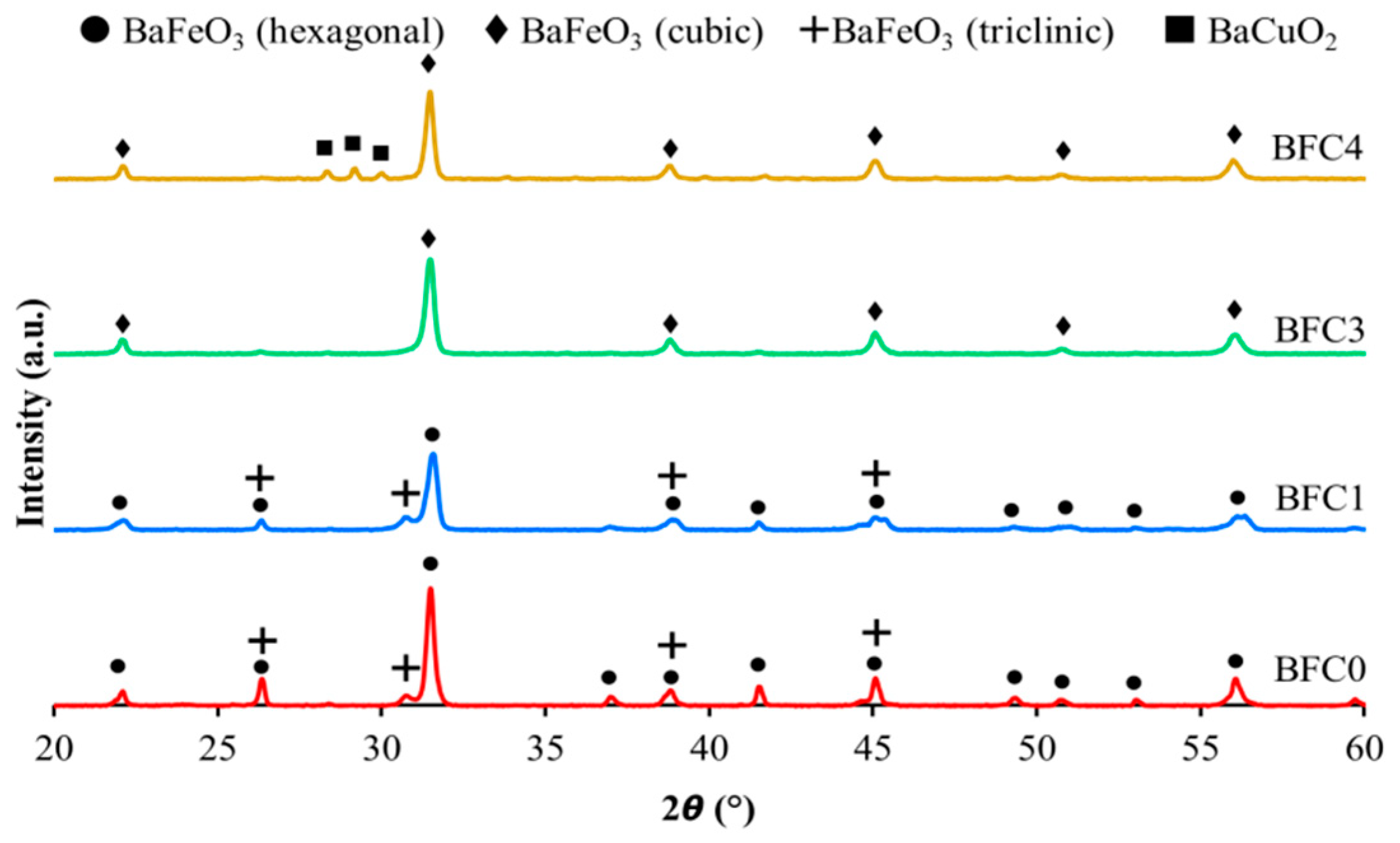

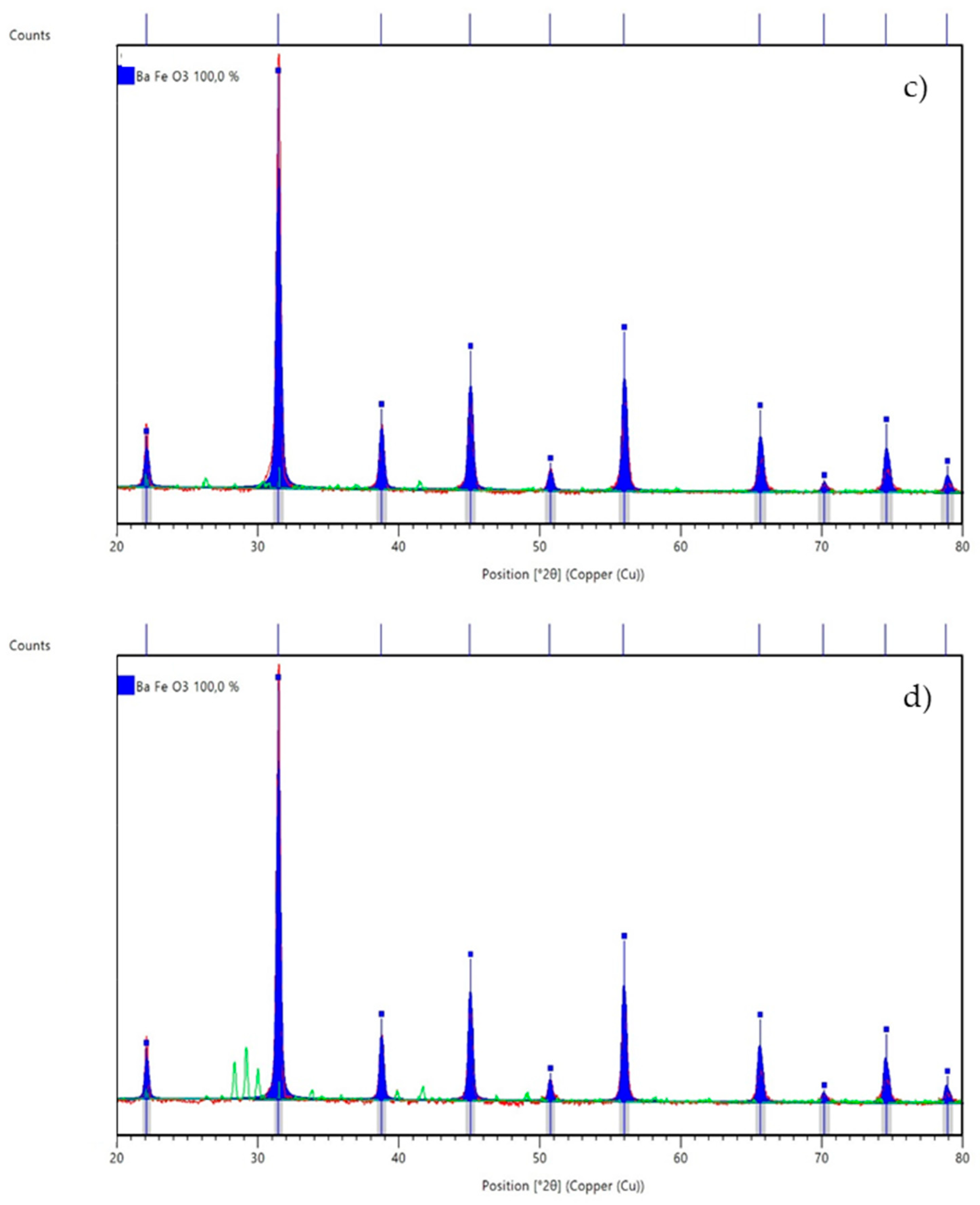

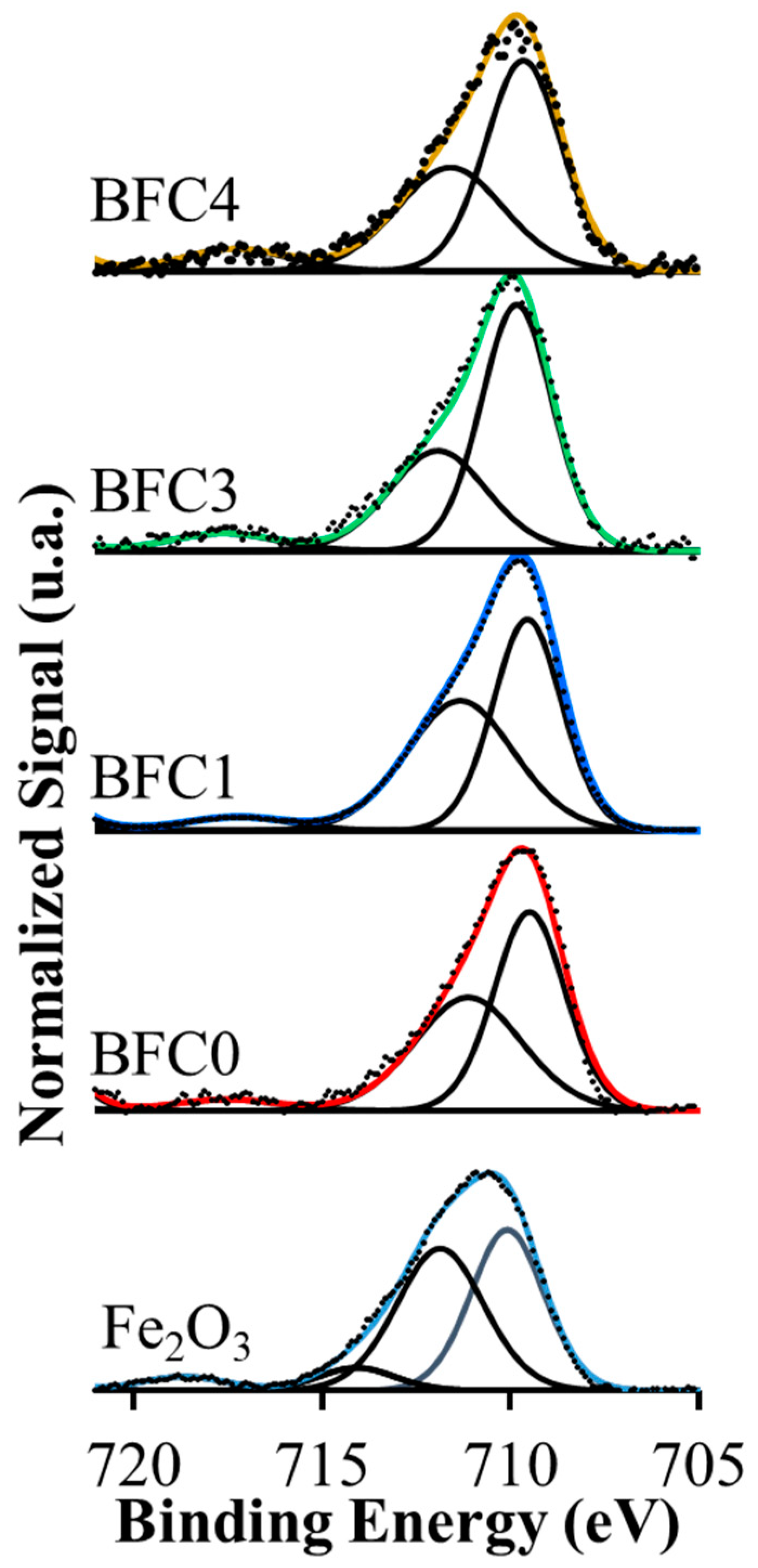
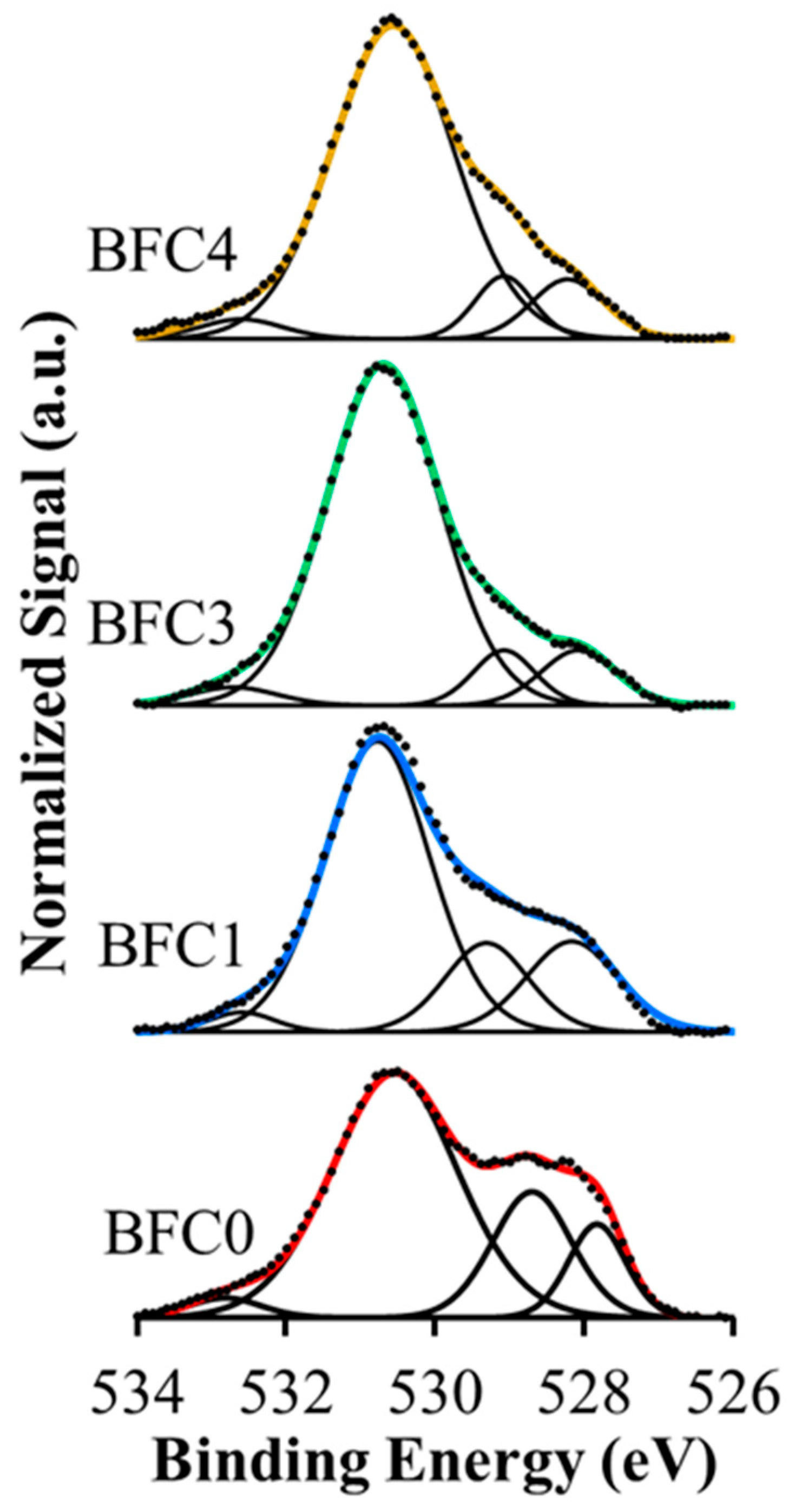
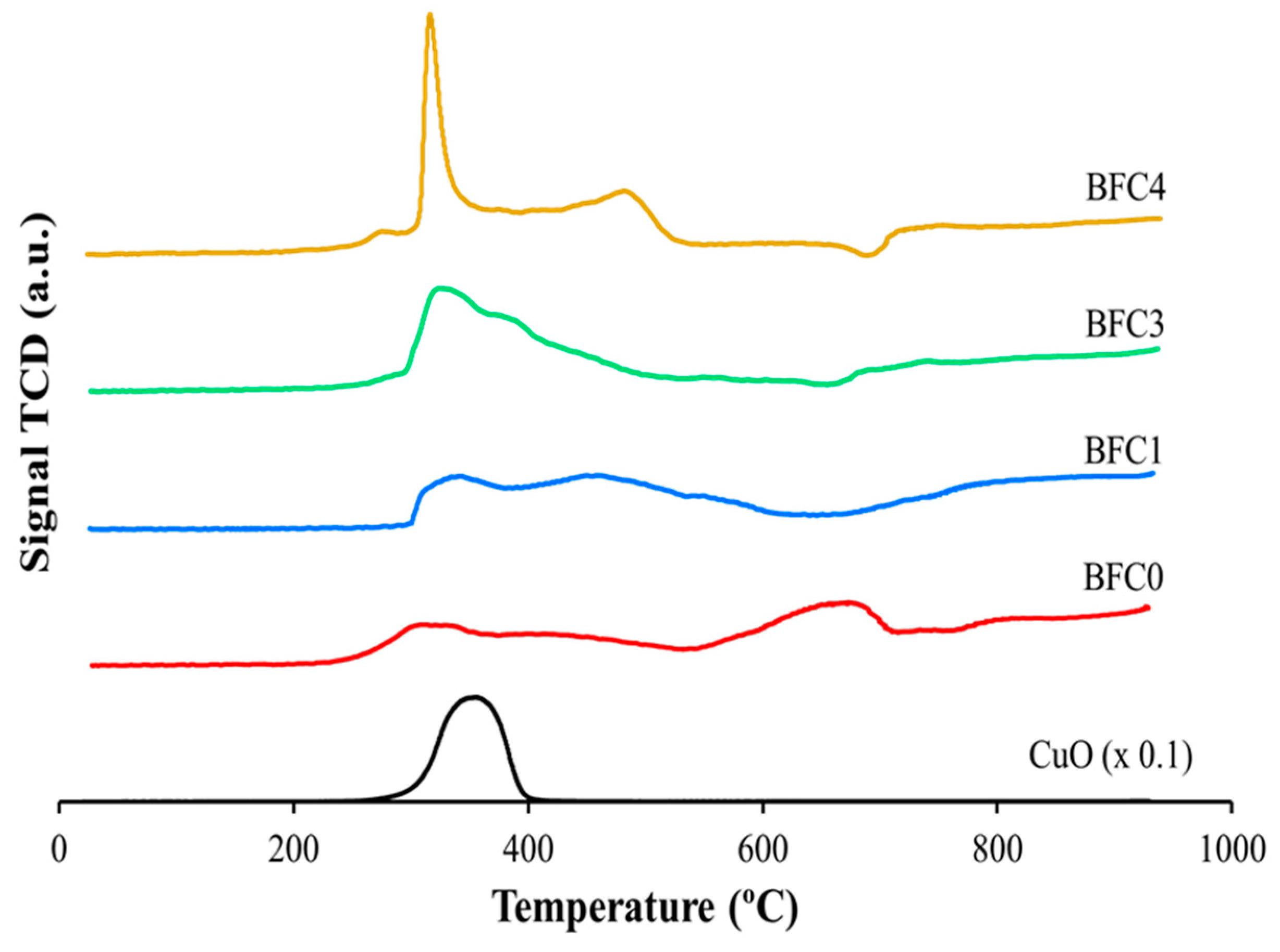
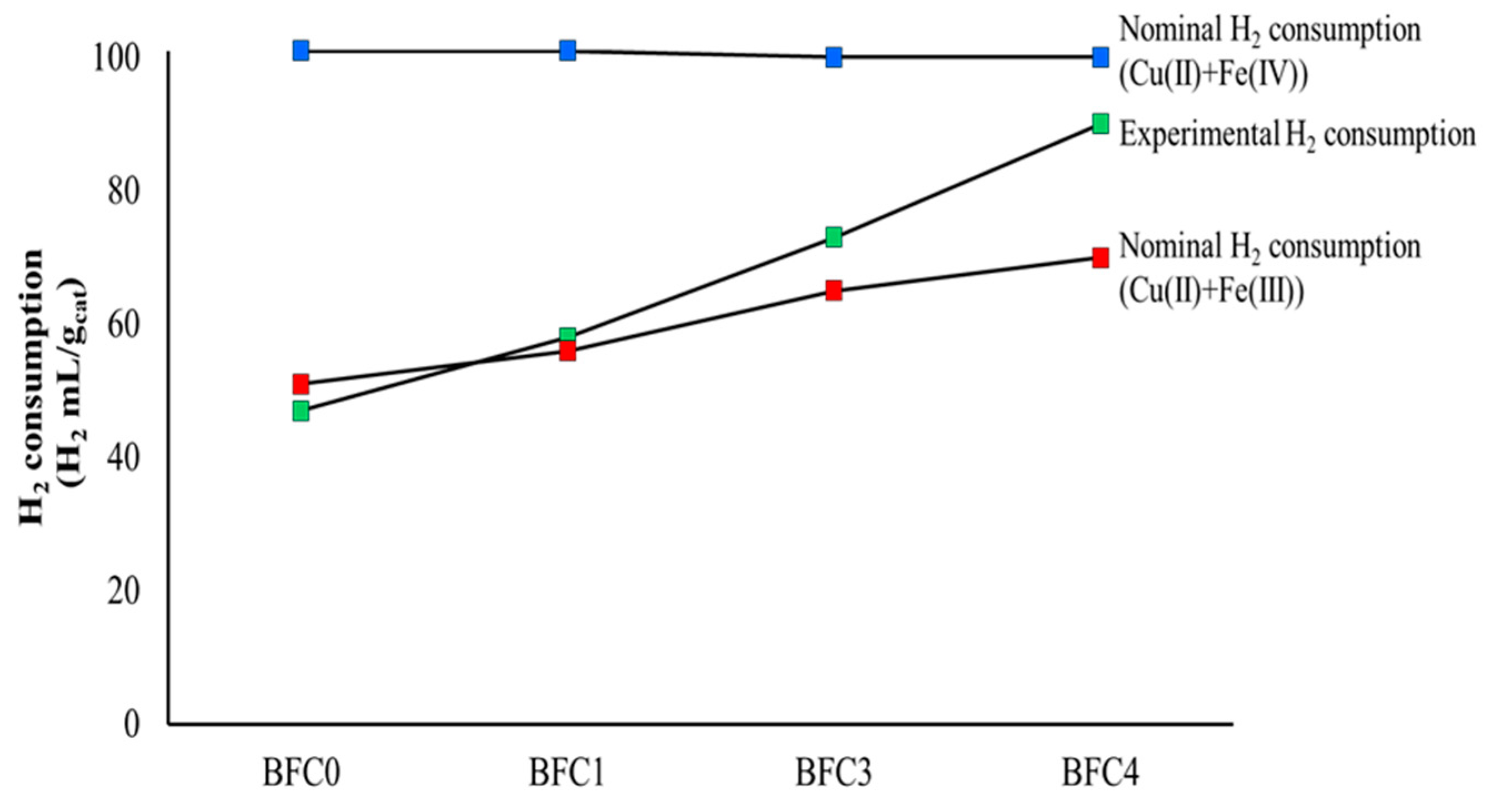
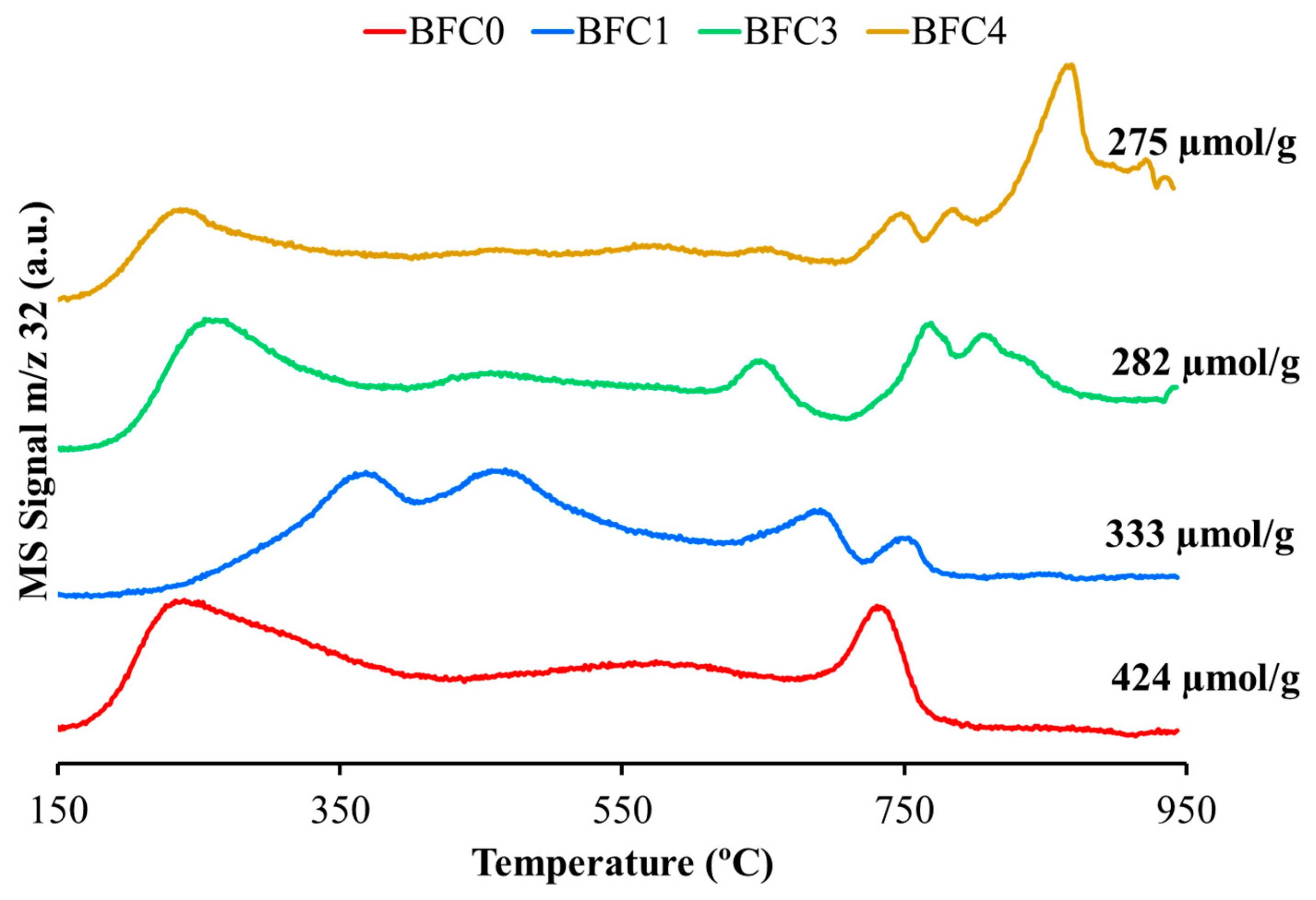
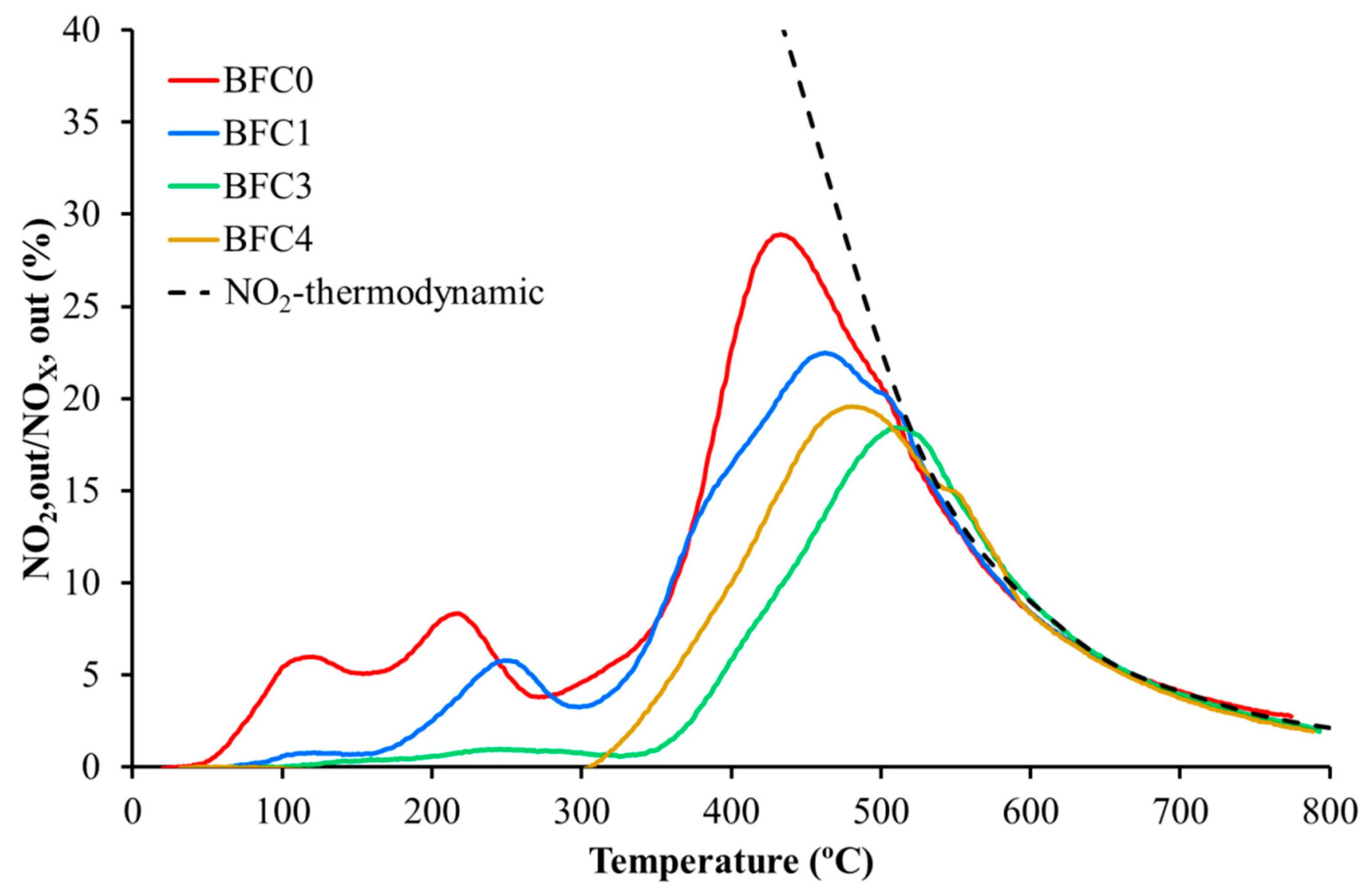
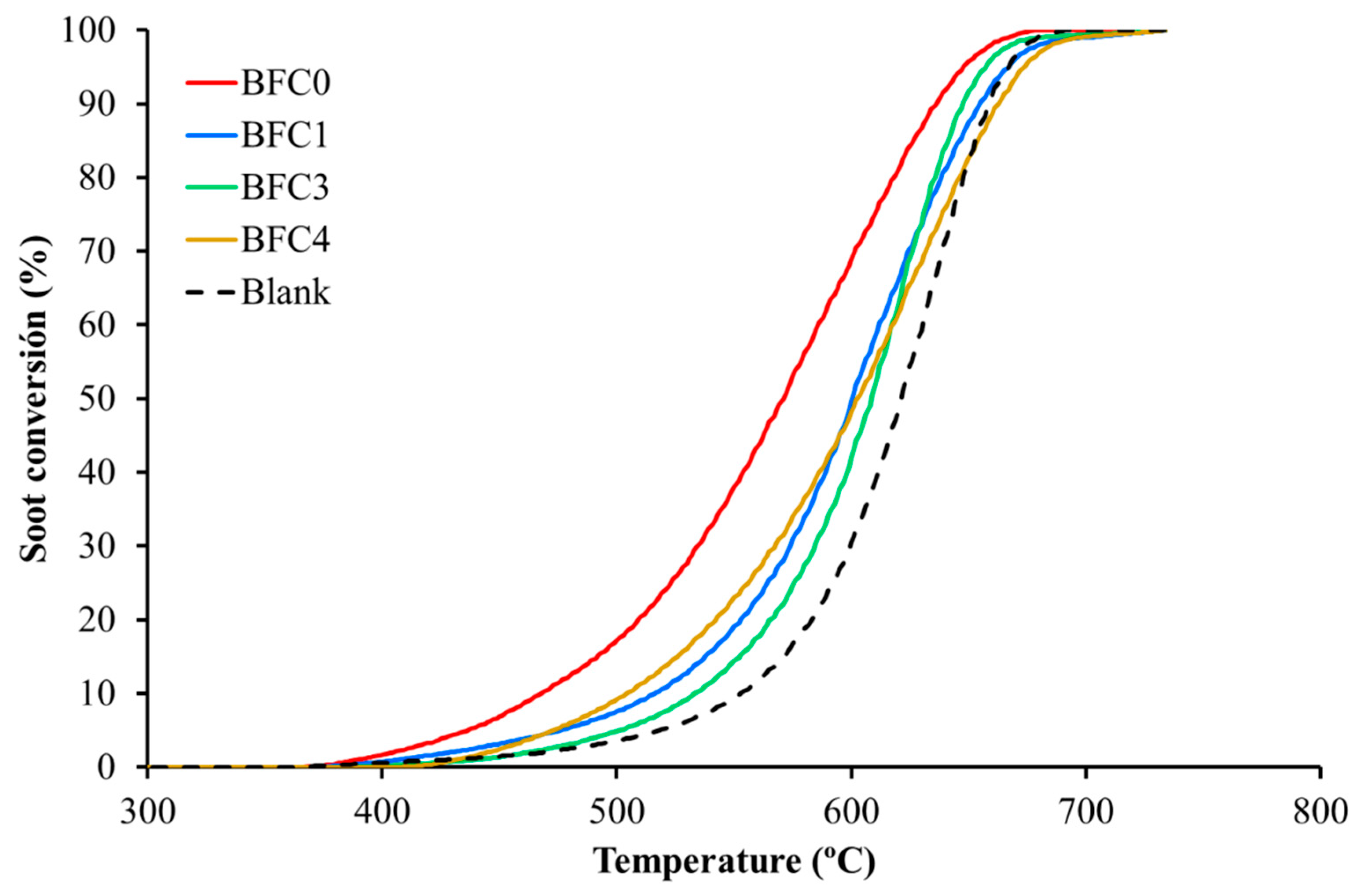

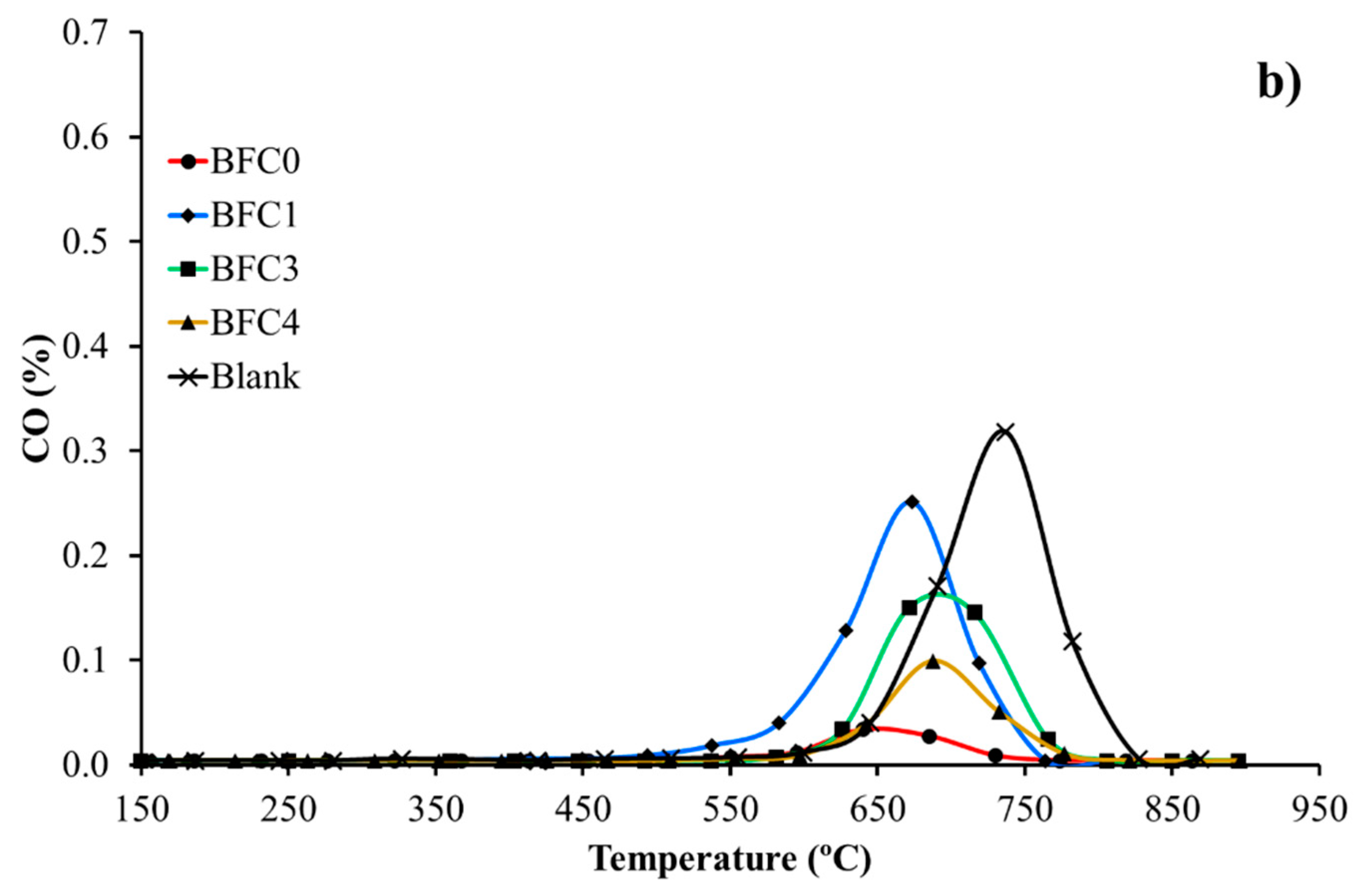
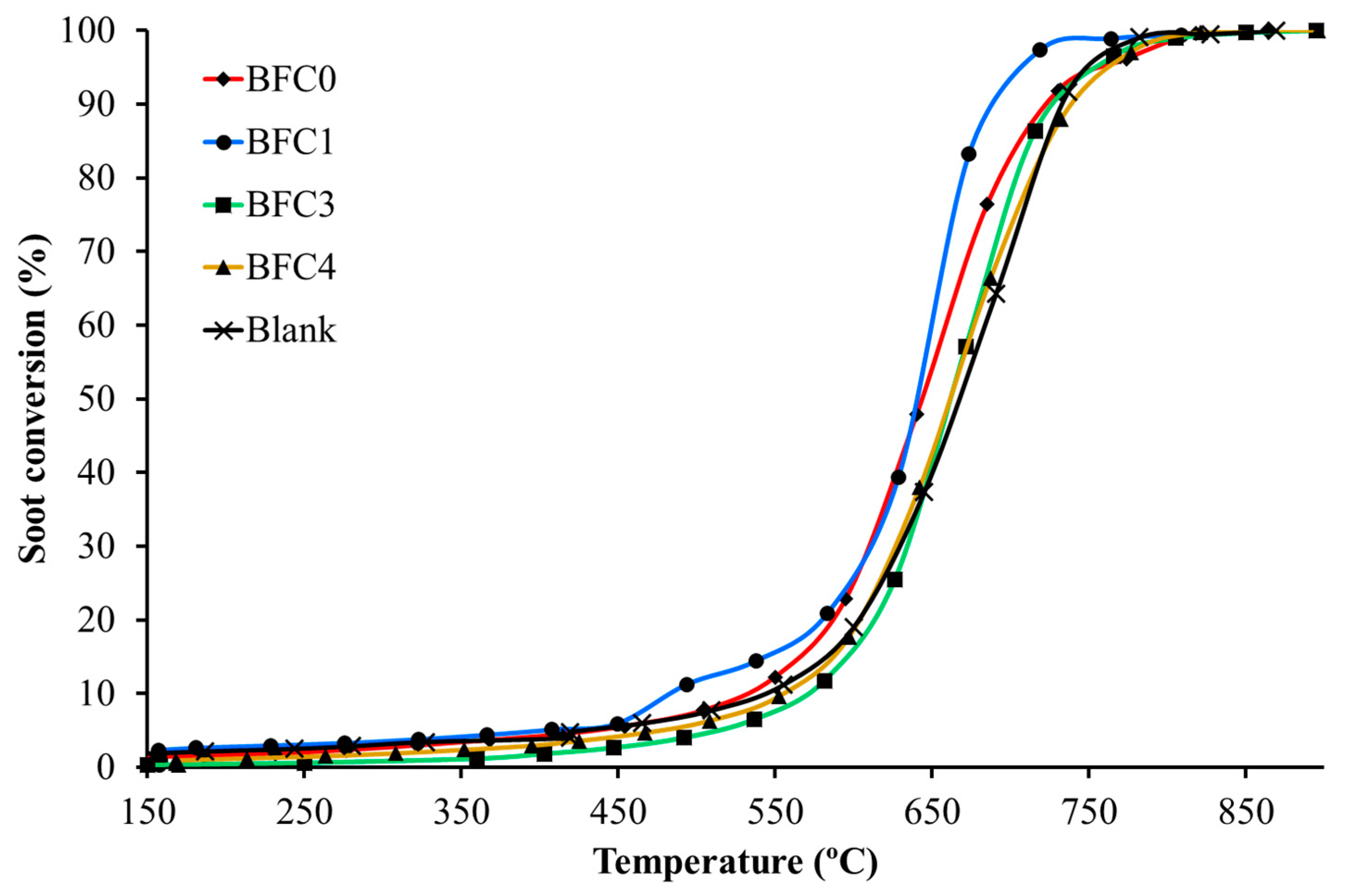
| Catalyst | Molecular Composition | BET Specific Surface Area (m2/g) * | Nominal Cu (wt %) | ICP Cu (wt %) | T (Fe3+) ** | t (Fe4+) ** |
|---|---|---|---|---|---|---|
| BFC0 | BaFeO3 | 4 | -- | -- | 1.09 | 1.12 |
| BFC1 | BaFe0.9Cu0.1O3 | 1 | 2.5 | 2.5 | 1.09 | 1.12 |
| BFC3 | BaFe0.7Cu0.3O3 | 1 | 7.7 | 7.0 | 1.08 | 1.10 |
| BFC4 | BaFe0.6Cu0.4O3 | 3 | 9.1 | 9.1 | 1.07 | 1.09 |
| Catalyst | XRD Phase Identification | Average Crystal Size (nm) * | a (Å) * | c (Å) * |
|---|---|---|---|---|
| BFC0 | BaFeO2.67, hexagonal | 17.0 | 5.684 | 13.925 |
| BFC1 | BaFeO2.67, hexagonal | 12.4 | 5.667 | 13.908 |
| BFC3 | BaFeO3, cubic | 14.3 | 4.019 | - |
| BFC4 | BaFeO3, cubic, Ba0.9Cu1.06O2.43 | 16.9 | 4.018 | - |
| Catalyst | Cu/ Ba+Fe+Cu (nominal) | Cu/ Ba+Fe+Cu (XPS) | OL/ Ba+Fe+Cu (XPS) |
|---|---|---|---|
| FC0 | - | - | 1.30 |
| BFC1 | 0.05 | 0.03 | 1.70 |
| BFC3 | 0.15 | 0.09 | 1.10 |
| BFC4 | 0.20 | 0.21 | 1.10 |
| Catalysts | T5% (°C) | T50% (°C) | CO2 Selectivity (%) |
|---|---|---|---|
| Bare soot | 480 | 612 | 41 |
| BFC0 | 430 | 543 | 51 |
| BFC1 | 455 | 605 | 70 |
| BFC3 | 480 | 605 | 66 |
| BFC4 | 454 | 590 | 90 |
© 2019 by the authors. Licensee MDPI, Basel, Switzerland. This article is an open access article distributed under the terms and conditions of the Creative Commons Attribution (CC BY) license (http://creativecommons.org/licenses/by/4.0/).
Share and Cite
Torregrosa-Rivero, V.; Moreno-Marcos, C.; Albaladejo-Fuentes, V.; Sánchez-Adsuar, M.-S.; Illán-Gómez, M.-J. BaFe1−xCuxO3 Perovskites as Active Phase for Diesel (DPF) and Gasoline Particle Filters (GPF). Nanomaterials 2019, 9, 1551. https://doi.org/10.3390/nano9111551
Torregrosa-Rivero V, Moreno-Marcos C, Albaladejo-Fuentes V, Sánchez-Adsuar M-S, Illán-Gómez M-J. BaFe1−xCuxO3 Perovskites as Active Phase for Diesel (DPF) and Gasoline Particle Filters (GPF). Nanomaterials. 2019; 9(11):1551. https://doi.org/10.3390/nano9111551
Chicago/Turabian StyleTorregrosa-Rivero, Verónica, Carla Moreno-Marcos, Vicente Albaladejo-Fuentes, María-Salvadora Sánchez-Adsuar, and María-José Illán-Gómez. 2019. "BaFe1−xCuxO3 Perovskites as Active Phase for Diesel (DPF) and Gasoline Particle Filters (GPF)" Nanomaterials 9, no. 11: 1551. https://doi.org/10.3390/nano9111551





